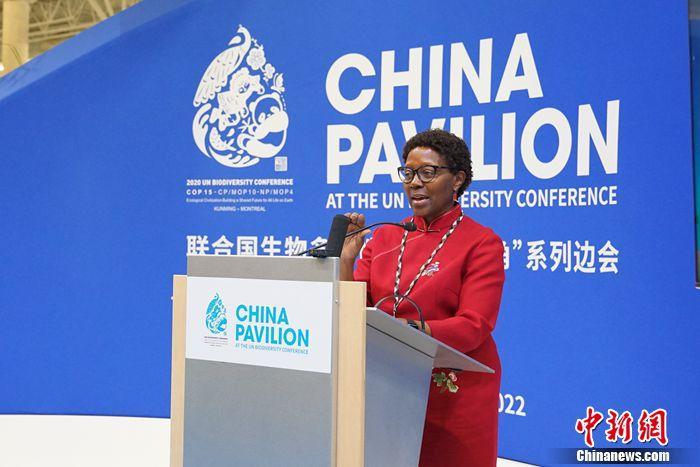Chinanews.com, Montreal, December 8: “China has made remarkable achievements in biodiversity conservation and plays a key role in promoting global biodiversity conservation.”
On December 7 local time, the side event of the second phase of the 15th meeting of the Conference of the Parties to the Convention on Biological Diversity (COP15) “Insist on the harmonious coexistence of humans and nature to build a clean and beautiful world” was held in Montreal, Canada. International participants spoke positively about biodiversity conservation practices in China and looked forward to the adoption of the “Post-2020 Global Biodiversity Framework” in the second phase of the meeting, which will start a new journey in biodiversity governance.
Elizabeth Murema, Executive Secretary of the United Nations Convention on Biological Diversity, delivered a keynote speech at the side event. Photo by Yin Ling
The international people praise China’s biodiversity conservation achievements
“China has made outstanding achievements in biodiversity conservation.” Murema, executive secretary of the Secretariat of the United Nations Convention on Biological Diversity, said that as the largest developing country in the world, China plays a unique role in the field of biodiversity conservation. It has embarked on a development path that not only improves people’s living standards, but also better protects the ecology and provides a model for developing countries to emulate and learn from.
Lambertini, Global Director-General of WWF, said that China has actively participated in the process of global environmental protection, especially since it has taken a number of measures since it took over the presidency of COP15, which is very encouraging. “In the next two weeks, we will hear more about China’s experience.”
The Chinese representative said that as the chairman of COP15, China held this side meeting to further consolidate the global consensus on the protection of biodiversity and promote the second phase of COP15 to achieve an ambitious, balanced, pragmatic, effective, powerful and transformative” Post-Global Biodiversity Framework 2020″.
Through years of hard work, biodiversity conservation in China has made remarkable achievements, effectively protecting 90% of terrestrial ecosystem types and 74% of major populations of nationally protected wild animals and plants. The newly added forest area it ranks first in the world and over 300 rare and endangered Wild animal and plant populations have been well restored.

“Insisting on the harmonious coexistence of man and nature to build a clean and beautiful world” side event site. Photo by Yu Ruidong
Biodiversity protection in China directly benefits from the concept of harmonious coexistence between humans and nature, and has given rise to many beneficial explorations and practices. China has improved its institutional mechanisms and policies to promote the mainstreaming of biodiversity protection; actively promoted the construction of a system of nature reserves with national parks as the main body and transformed the relationship between man and nature from a demand to a protection; vigorously promoted the integration of mountains, rivers, forests, fields, lakes, grass and sand Protection and systematic governance form a strong joint force for the whole society to protect the ecological environment; insist that green water and lush mountains are golden mountains and silver mountains, and establish and improve the value realization mechanism of green products.
Craig Hansen, vice president and chief executive officer of the World Resources Institute, said China has made remarkable achievements in biodiversity conservation over the past decade, including drawing red lines of ecological protection, announcing the establishment of the Kunming Biodiversity Fund, and increasing conservation of biodiversity. funds etc.
Solheim, the former UN undersecretary-general, said that Chinese President Xi Jinping’s concept of “Beautiful China” has a positive meaning: conservation becomes a positive force.
“In terms of size and influence, China plays a key role in promoting global biodiversity conservation.” Dai Qingli, vice president and president of the Paulson Institute, pointed out that China is rich in biodiversity and home to many rare species. The effective protection of these natural treasures is in itself a great contribution to the cause of the conservation of global biodiversity.
Waiting to adopt a “new project” for the conservation of global biodiversity
It is the ardent expectation of the international community to embark on a new journey towards global biodiversity governance. An important objective of the second phase of COP15 is to formulate the ‘Post-2020 Global Biodiversity Framework’ and chart a new blueprint for global biodiversity governance before 2030 and beyond.
The side event was hosted by the Environmental and Economic Policy Research Center of the Ministry of Ecology and Environment, China News Service, and carried out by China News Network. The Chinese representative expressed the hope that all parties jointly promote the long-awaited, ambitious and pragmatically balanced “post-2020 global biodiversity framework” to curb and reverse the grave situation of biodiversity loss and embark on the road to a bright future of harmonious coexistence between man and nature.

Stephen DeBoer, Deputy Assistant Minister for International Relations of Environment and Climate Change Canada, gave a keynote speech at the side event. Photo by Yin Ling
Stephen de Boer, Deputy Assistant Minister for International Relations at Canada’s Ministry of Environment and Climate Change, expressed hope that all parties could work together to achieve a “post-2020 global biodiversity framework”, which will bring of countries around the world to curb biodiversity, sex loss and the degradation of nature and ecosystems.
Guests engaged in heated discussions on relevant topics. To keep the idea of a beautiful home in mind, Solheim said, developing a positive agenda to protect nature must work with local people. Only in this way can we succeed and create a harmonious symbiosis between man and nature.
On how to save biodiversity over the next ten years, Craig Hansen has proposed a framework path of “produce, conserve, reduce, restore”. This strategy will not only help meet human needs and promote human economic development, but will also protect all forms of biodiversity Diversity of life, including genetic diversity, species diversity and ecosystem diversity.
Dai Qingli believes that this meeting has assumed an important historic mission: to build a global consensus, catalyze powerful action, effectively curb and reverse the trend of global biodiversity loss, and prevent the global ecology from coming to an end. The annual global funding gap for biodiversity conservation reaches $700 billion. To fill this gap, a two-pronged approach is needed: while mobilizing more resources to invest in biodiversity conservation, policies and behaviors that harm nature, such as various subsidies and investment development projects that harm nature, need to be reduced.
The Chinese representative stressed that looking to the future, China will promote the implementation of major biodiversity protection projects and ecosystem protection and restoration measures, and use the natural way to feed all living things, and seek new opportunities for the green development by protecting nature. At the same time, work together with other countries to build a clean and beautiful world.


